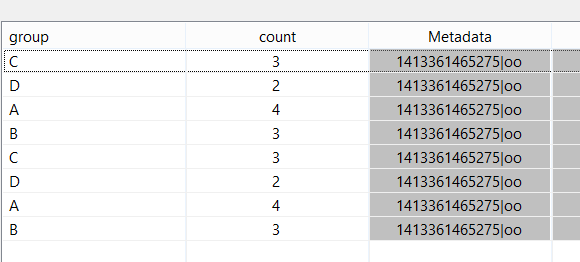
This Operator can be used to combine sequent elements, e.g. by a set of grouping attributes or with a predicates.
Warning: This operator ignores timestamps, so the result may not be valid regarding temporal correctness! If you want to garantee temporal correctness use Window operator and Aggregate (and Group) operator
In the attributes case, the elements are merged with also given aggregations functions, as long as the grouping attributes (e.g. a sensorid) are the same. When a new group is opened (e.g. a measurement from a new sensor) the old aggregates values and the grouping attributes are created as a result.
In the predicate case, the elements are merged as long as the predicates evaluates to false, i.e. a new tuple is created when the predicates evaluates to true. If you want to aggregate as long, as the predicate is true, simply use !(predicate) as predicate.
coalesce = COALESCE({ATTR=['sensorid'],
AGGREGATIONS=[['AVG','temperature','temperatur']]},tempSensor1)
coalesce = COALESCE({predicate='temperature>=10',
AGGREGATIONS=[['last','temperature','temperature'], ['AVG,'temperature','avgTemp']]},tempSensor1) |
A new version of the coalesce operator can combine attr and predicates:
Here is an example to explain this operator:
When using the following file (startstopinput.csv) as input
A;0 B;0 C;0 C;1 D;0 A;1 A;1 D;1 A;1 B;1 A;1 B;1 B;1 C;1 C;1 D;1 B;0 A;0 B;0 D;0 C;0 A;0 B;0 C;0 C;1 D;0 A;1 A;1 D;1 A;1 B;1 A;1 B;1 B;1 C;1 C;1 D;1 B;0 A;0 B;0 D;0 C;0 |
You can define the following query:
#PARSER PQL
#ADDQUERY
in = CSVFILESOURCE({
filename = '${WORKSPACEPROJECT}/startstopinput.csv',
source = 'source',
delimiter = ';',
schema = [['group', 'String'], ['v', 'Integer']]
}
)
out = COALESCE({
aggregations = [['COUNT', 'v', 'count']],
startpredicate = 'v>0',
endpredicate = 'v=0',
ATTR = ['group']
},
in
) |
Here for each group (A,B,C and D) the counting starts, when v is larger that 0 and stops when v is zero.
The output for the query can be found here:

Order is from bottom to top.